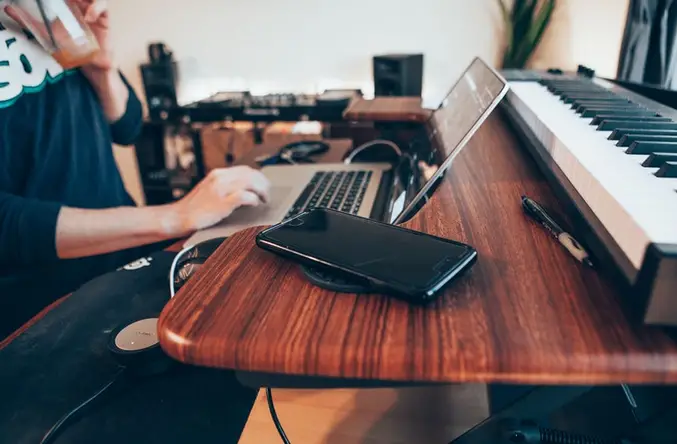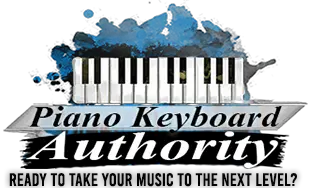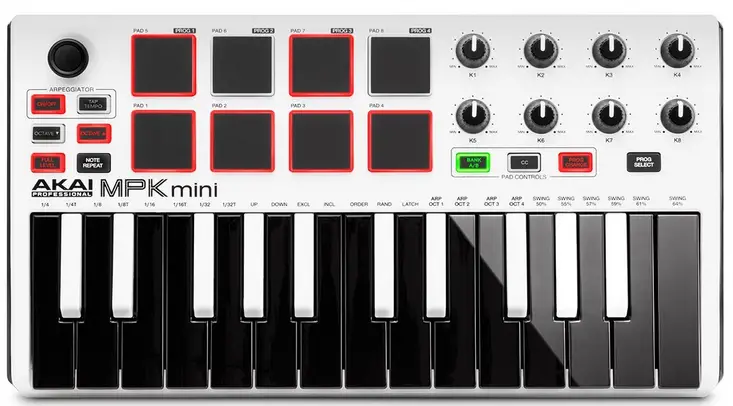
Table of Contents
Keyboard Abundance – And How to Handle it
The other day, I googled “the best keyboards for music production,” and I can describe the resulting experience with one word: overwhelming. Friends, there are countless options available. Lucky for you, the following article has streamlined the process. Here, I’ll talk about a few keyboards that have often popped up in the blogs and forums of the endless interwebs.
Before we dive in to the nitty-gritty, let us clear up any potentially lingering confusion around keyboards and electric pianos and what each have to offer.
Electric pianos and synthesizer keyboards look pretty similar from the outside. They both typically have white and black keys, organizing the sharps and flats into the intuitive musical map that many of us are familiar with. The primary differences between the two is in the playability:
Synthesizer Keyboards need to be connected to music production software to be played, while electric pianos can play with a power supply alone. Synthesizer keyboards often (but not always) come with velocity sensitive keys, and though somewhat realistic, these keyboards typically don’t carry the full 88 keys you’ll find on a piano. But, don’t worry, these keyboards will have octave up/down buttons to help you find those extra notes.
Most high end electric pianos carry 88 velocity sensitive GHS (Graded Hammer Standard) keys, feeling heavier to the touch on the low end, and getting lighter as you go up in pitch for a vividly real piano playing experience.
Finally, with sound, electric pianos are designed to give you the most realistic and natural piano experience. Synthesizer keyboards often will have a realistic piano sound, but through the music production software, you’ll have access to a wide variety of other sounds to program your keys and drum pads with, all adjustable with on-board wheels, knobs, joysticks and more to manipulate your unique sound.
OUR KEYBOARDS
 M-Audio Oxygen 25/49/61 MKIV
M-Audio Oxygen 25/49/61 MKIV
First on our list is the M-Audio Oxygen 49 MKIV. This synthesizer keyboard looks sleek, feels sleek, and its capabilities in terms of performance are nothing short of excellent.
The names of each of these three models correspond with the number of keys each keyboard has. I.E. 25 = 25 keys, etc. Each model comes with pressure sensitive and velocity sensitive keys, giving you more room to express yourself. Octave up and down buttons are built in, allowing you full note range of a standard piano. Located on the top right corner of this keyboard are 8 assignable, velocity sensitive, and backlit drum pads. These pads are programmable to hold virtual instrument sounds, triggering loops, and much more.
Left of these pads are 9 fully assignable faders, and 8 fully assignable knobs.
Two pitch-bend and modulation wheels are built in left of the keys, each with a finger sized indent for ease of handling. These wheels are programmable with portamento, vibrato, and other modulation effects.
Paired with the sustain pedal input, this keyboard has an expansive dimension of expressiveness that you can explore through your music.
 Novation Launchkey 49 MKii
Novation Launchkey 49 MKii
Second on our list is the Novation Launchkey 49 MKii.
The velocity and aftertouch sensitive keys on board feel and sound very realistic and have a wide range of expressive capability.
Left of these keys are the two pitch-bend and modulation wheels. Similar to the wheels mentioned on the previous keyboard, these also come with the finger sized indent as well as programmability. Another way this keyboard mirrors the previous mentioned is the 8 rotary encoders and 9 faders.
The Novation Launchkey boasts a total of SIXTEEN velocity-sensitive, backlit pads. Each with color correspondence, making it easier to find your sounds once you’ve programmed them in.
With the LCD display on this keyboard, you can program all kinds of key slips, layers, and midi controller messages to your faders, encoders, and pads.
On the back, you’ll find a USB port, quarter-inch jack, and power connection. The USB port handles your midi connection, while the quarter inch jack holds the input for your sustain pedal.
The internal software of this keyboard is specifically designed to integrate effortlessly with Ableton Live. This enables you to have immediate access to your session grid, effects and instruments.
Akai Pro MPK Mini MKII
Third on our list of mention-worthy keyboards is the Akai Pro MPK Mini MKII. This keyboard is definitely on the smaller end, but when you take a look at all the benefits this keyboard brings, you’ll quickly realize that size doesn’t always matter.
The Akai was designed for a streamlined approach to portability and functionality. At 12.4 inches long weighing in at 1.6lbs, this keyboard can easily fit into any musicians backpack along with their laptop. With its USB port handling both the MIDI connection and power supply, you truly can take and make music anywhere you go.
25 mini velocity sensitive keys give you a comfortable amount of space for two handed chords, though the real opportunist will handle one handed chords with one hand while editing and mixing on their computer with the other.
The Akai has 8 fully assignable velocity-sensitive backlit pads, 8 fully assignable knobs, and even a 4-way pitch-bend modulation joystick. Yes, I said joystick. This is something that is not often found on other keyboards and is absolutely one of the features that brings the Akai into the spotlight.
Worried about software? This keyboard comes with its own software, providing an intuitive and immediate guide to this little powerhouse. If you’re really picky about which programs you use, this keyboard can seamlessly integrate with more standard programs like FL studio.
Also, did I mention its under $100? Yeah. I know. Bearing in mind, Amazon does change their price from time to time. If you want to read more about this keyboard, (here) is an article written on it not too long ago. Seriously, go check it out!
 Yamaha MOXF8 Music Production Workstation
Yamaha MOXF8 Music Production Workstation
So far we’ve covered a couple keyboards that are reasonably well below $1000. While those keyboards are more than enough to make some beautiful pieces of musical art… we can get even fancier.
Ladies and gentlemen, I present to you the music production powerhouse: the Yamaha MOXF8. This colossally awesome machine boasts a full count of 88 Graded Hammer Standard keys, providing an undeniably realistic piano experience when played.
Through this keyboards category search mode, you’ll find 16 different instrument categories. Beyond that, each of the 16 categories have their own sub-categories. The LCD screen and button layout on the keyboard makes this a fairly quick and intuitive process, helping you find the exact sound you’re looking for.
Yamaha’s MOXF models come with a wide variety of softwares, helping streamline your music production process. These include but are not limited to:
- MOXF Editor
- MOXF Remote Editor
- Remote tools
With a single USB cable, you can transmit both audio and MIDI data between your music production keyboard and your computer.
The MOXF has the capability to take two other audio inputs and multiplex them onto a one USB output. This allows you to have two other musicians with you, everyone playing at the same time, and be able to record it all through your keyboard onto a single computer.
The details and features of this machine go deeper and deeper, and if you’ve got the resources to handle its definitely-not-amateur price tag, feel free to head to amazon and check this beast out HERE!
Find The Best Keyboard for Music Production For You
Guys, i’m not gonna tell you that choosing a music production keyboard is easy. The amount of keyboards out there is endless and still growing.
Simply put, what it all boils down to is you as the music artist, and your priorities. The Akai is great for its portability, the M-Audio Oxygen and Novation are extremely well rounded keyboards, and Yamaha continues to maintain their professional standard by blowing everyone out of the water (though, not without a price).
What you may find is that with a healthy amount of research, and defining your music production necessities, any keyboard that you choose will leave you happy and satisfied. I wish you the best of luck in picking and choosing your next beautiful instrument.


